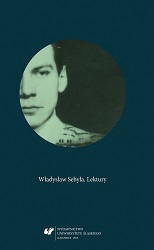Wyobraźnia katastroficzna. Władysława Sebyły
The Catastrophic Imagination of Władysław Sebyła
Author(s): Stanisław Dłuski
Subject(s): Language and Literature Studies, Studies of Literature, Polish Literature, Theory of Literature
Published by: Wydawnictwo Uniwersytetu Śląskiego
Summary/Abstract: The author discusses the type of Władysław Sebyła’s poetic imagination and imagery, oscillating around the broadly understood catastrophic trend which dominated the landscape of Polish poetry in the 1930s. To that end, the author identifies the most important motifs and imageries characteristic of Sebyła’s poetry, in order to show that it was artistically independent from the influence of group poetics – even though the poet debuted under the ideological banners of Kwadryga – politics and the popular ideologies of that time. Even in the strictly formal aspect, Sebyła was always seeking his own niche, criticizing, also in his capacity as a literary critic, the passive influence of the Vanguard of Kraków and Skamander – the two most important interwar literary groups. The lyrical I in Sebyła’s poetry constantly seeks and misses God. According to the author of the article, it is precisely this search for sacrum understood as a constant and reliable system of values, which led Sebyła to creative and mystical poetry. This turn towards the sacrum constitutes the most radical response to the absurdity and historiosophical pessimism, while Sebyła’s legacy is inherited by the subsequent generations of poets: Baczyński (visionary aspect, type of imagination), Różewicz (the world seen as a “garbage bin”) or Barańczak (the idea of God). Sebyła’s faith was influenced in equal parts by the Christian gnosis, mysticism, as well as apophatic theology,which seems to be generally omitted by literary criticism on the topic.
Book: Władysław Sebyła. Lektury
- Page Range: 29-50
- Page Count: 22
- Publication Year: 2017
- Language: Polish
- Content File-PDF

